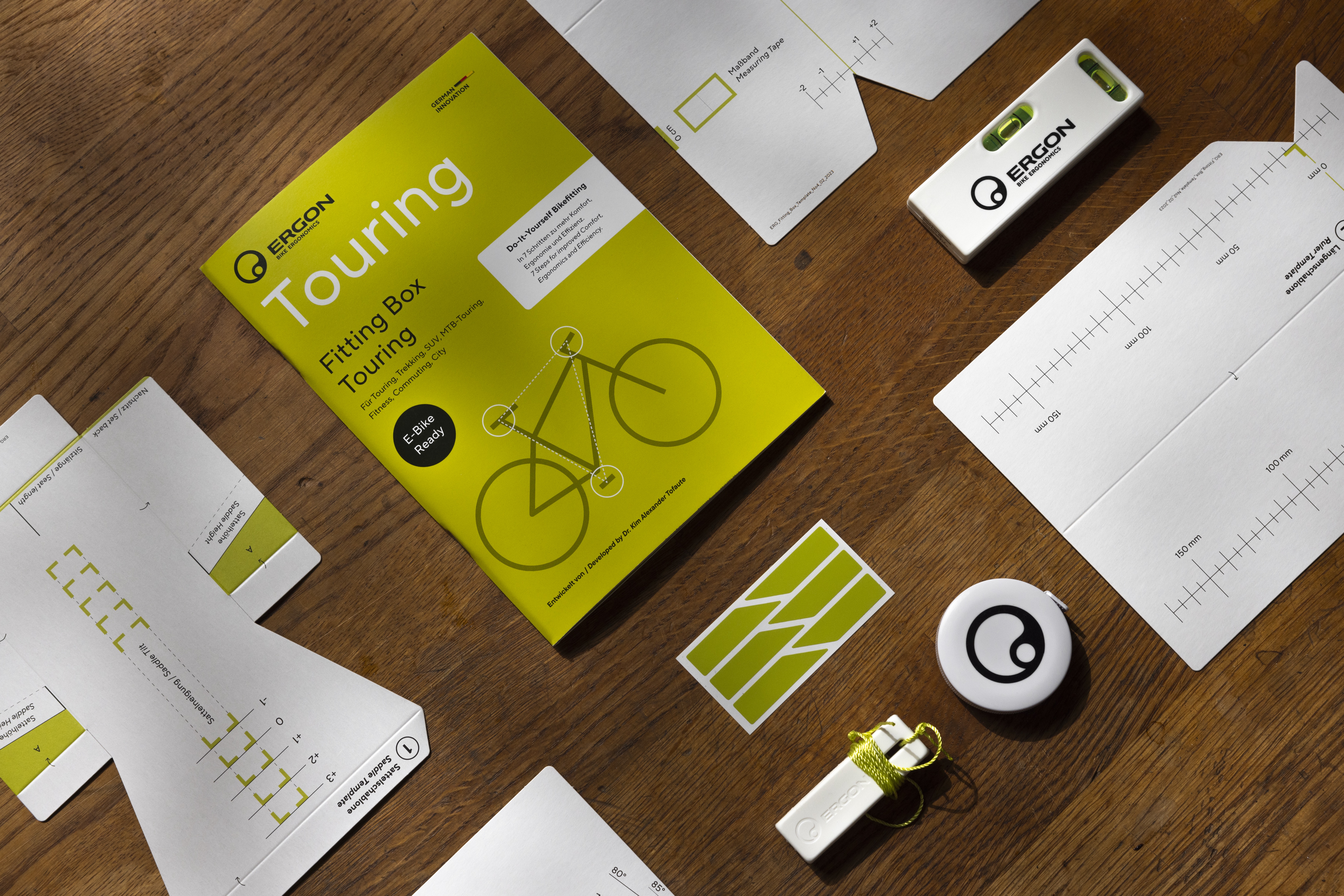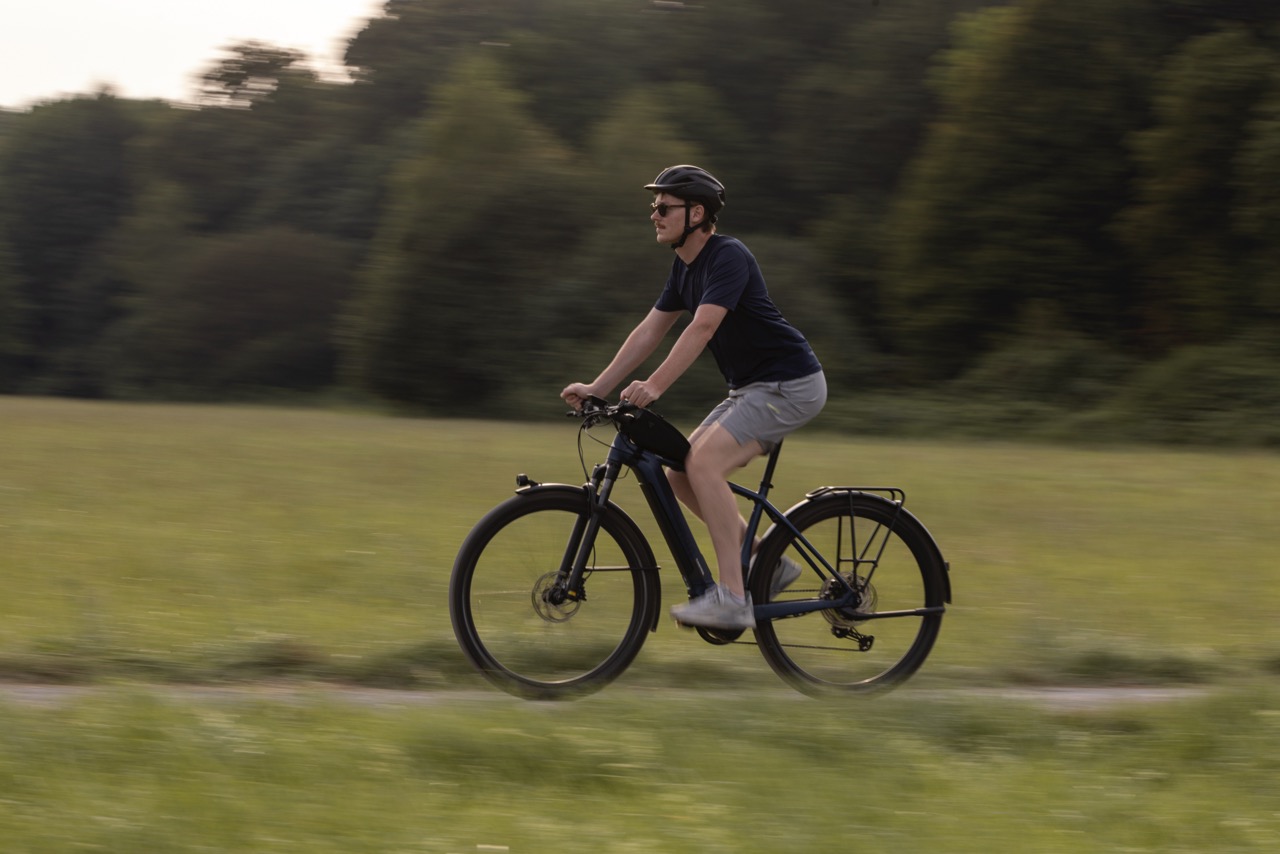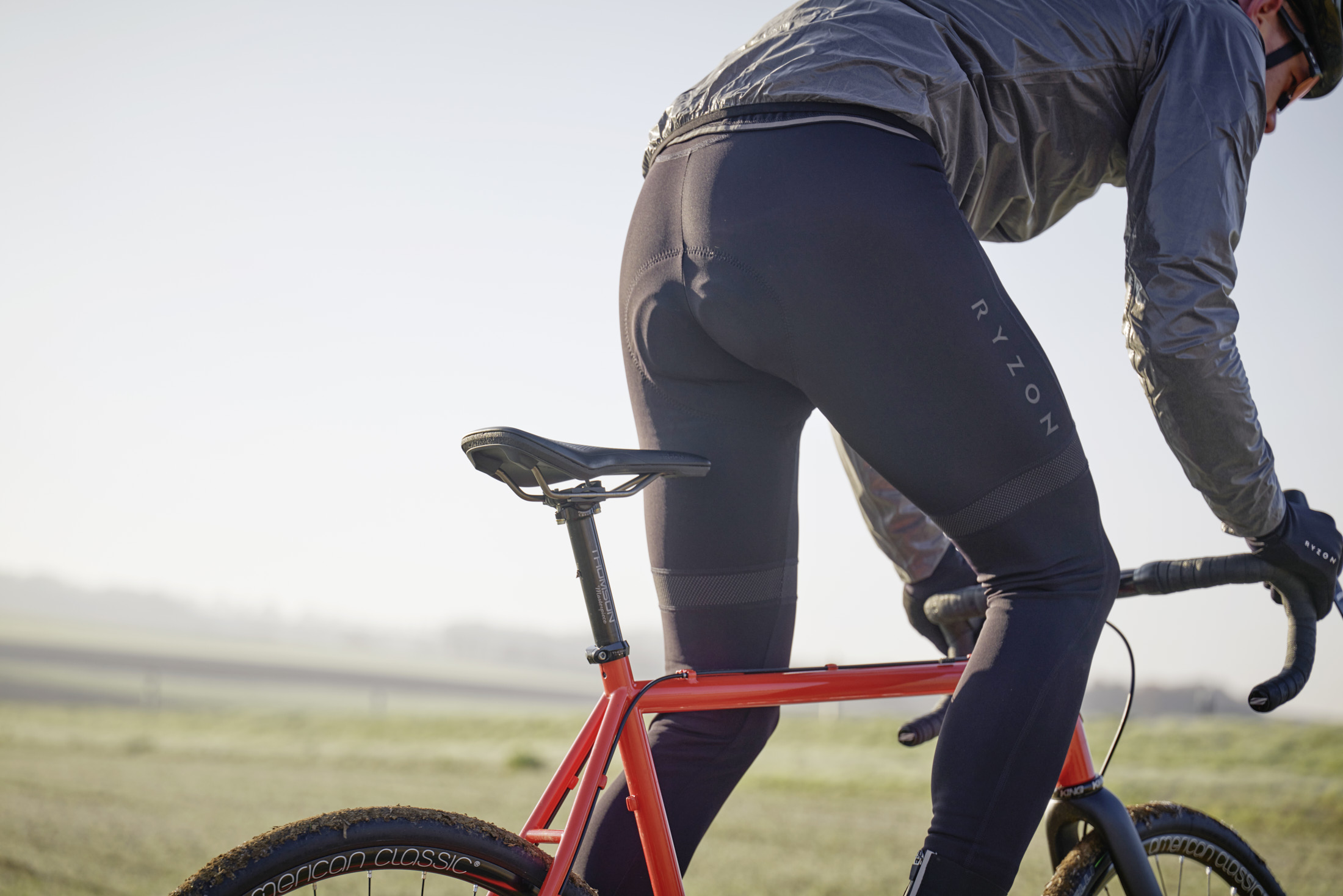Knee Pain While Cycling – What Could Be the Cause?

Knee pain while cycling? Who hasn't experienced that sudden knee twinge during a bike ride? Our ergonomics experts will tell you how to avoid it.
Knee Pain While Cycling
Besides swimming, cycling is one of the healthiest low impact sports. You don't have to support your body weight, you can control your effort with the gears of the bicycle, route selection, the use of an e-bike motor, and the pedaling motion is natural and anatomically correct for your joints. The Cologne Sports University categorizes cycling as a "low impact" sport with very few harmful side effects, even recommending the bike as a therapeutic tool for gonarthrosis, which is excessive wear of the joint surfaces in the knee. But aside from pre-existing knee damage or improper bike settings: Our bodies, and especially our knees, were not evolutionarily designed for pedaling, so knee pain while cycling or knee pain after cycling can occasionally occur.
Pain While Cycling Doesn't Have to Be
Unfortunately, too many cyclists accept pain, don't investigate possible causes, and often overlook the relatively simple solutions. In addition to possible pre-existing knee damage, incorrect foot position on the pedals, insufficiently flexible or strong muscles in the legs and hips, and errors in bike fit can also cause knee pain. The fact is, for healthy and moderately flexible people, cycling should not lead to knee problems or chronic pain. The first and most important prerequisite for joint-friendly cycling is that the knees can transfer the relatively high torque when pedaling, i.e., the physical force generated by the hip and leg muscles, as straight as possible towards the lower leg and thus towards the pedal. When the joint surfaces in the knee are aligned, the torque is distributed over the largest possible area, no spot in the knee is excessively stressed, worn, or damaged. If the knee joint can then operate within its most efficient window between 70° flexion and under 150° extension, nothing stands in the way of tens of thousands of pain-free kilometers.

Why Do I Have Knee Pain While or After Cycling?
The connection between pain and cause in the knee can be relatively easily determined and then eliminated. Unfortunately, the pain location rarely corresponds exactly to the problem location; the cause can lie anywhere between the lower back and the tip of the foot. And very rarely do knee problems result from exactly one misalignment, incorrect bike setting, or a single imbalance in the body; combinations are much more likely. Three broad categories for the cause of knee pain on the bike can be distinguished:
- Your seating position, saddle position, and/or saddle height, including the placement of your feet on the pedal, are not correctly adjusted.
- There is an imbalance within your hip, leg, and/or core muscles, resulting in compensatory movements.
- You are not performing the pedaling motion correctly.
In the table below, you will see which errors lead to which symptoms and with which tips and exercises can help you eliminate knee pain. In most cases, checking the saddle height and setback is enough for mild knee problems. This measure indicates how far behind the bottom bracket the saddle center is located. According to the Institute for Natural Sports at the Cologne Sports University, about two-thirds of all cyclists sit too low. This affects everyday cyclists more than sports cyclists, but it is a remarkable fact. The position of the saddle in relation to the bottom bracket determines how much the knee bends and extends when pedaling and whether more pedaling power comes from the front thigh or the gluteal muscle. If the saddle is too low or too far forward, you start the pressure phase of the pedal cycle with a sharp, i.e., less than 90 degrees bent knee, and the efficiency of the thigh muscle decreases extremely from this bend. Additionally, the kneecap is pressed excessively onto the joint surfaces of the knee as a kind of deflection bearing for the force of the front thigh, called retro patellar pressure. Friction with a lot of pressure always means irritation of the affected tissue and, over time, more wear. The most likely reason so many low saddle settings is probably the fear of not being able to control the bike while standing, i.e., not being able to place both feet on the ground while sitting in the saddle. Even if this mainly concerns short-distance riders, commuters, children, and seniors, the question arises: Shouldn't I forgo the comfort of being able to stay in the saddle at traffic lights or intersections to cycle joint-friendly, with more power, and without knee pain? The professional bike fitters at Ergon say YES. Unfortunately, very few recreational cyclists seek professional help in this regard, relying more on feeling and appearance.
Good Saddle Adjustment Is Half the Battle
Those who use the Ergon Fitting Box to individually optimize the best seating position at home will, in most cases, subsequently set their saddle higher. The rule of thumb is that at the bottom of the pedal stroke, when the leg goes through its largest knee angle in the pedal cycle, there should still be a slight bend visible without sliding back and forth on the saddle or riding with a so-called pointed toes. This is how expert describes the foot position when the cyclist presses the forefoot significantly down with each pedal stroke, as if standing on tiptoes. The knee should never be completely straightened without such compensatory movements; this does not harm the kneecap tendon or the front joint surfaces but irritates the rear structures such as the tendons of the hamstring muscle. A saddle set too high only shifts the problem. If the knee angle fits at the bottom dead center, but the knee is still bent more than 90 degrees at the top, the crank is probably too long. This happens more often with small frame sizes, as the bike industry relies on standard crank lengths between 170 and 175 millimeters, which do not fit everyone's anatomy and pedaling technique. Cyclists with shorter legs – inseam under about 80 centimeters – do not find the crank length to be correct on stock bikes. Replacing the crank is not necessarily an inexpensive option, but it is a worthwhile investment.

Knee Pain Above and Below the Kneecap
More often than an incorrect saddle height, unfavorable knee angles result from incorrect setback and poor foot positioning on the pedal. The pain then occurs along the patellar tendon, especially at its attachments to the large thigh extensor and, somewhat less frequently, below the kneecap towards the shin. This can also be well managed with DIY bike fitting using the Ergon Fitting Box. The further the saddle is shifted towards the handlebars, the more the quadriceps femoris, the front thigh, works; the further back you sit, the more the gluteus maximus, the large gluteal muscle, works. Athletes like triathletes or bikepackers have different preferences here, but the knee prefers a neutral saddle position. Tip: When the cranks of the bike are horizontal, the tip of the knee and ball of the foot should be roughly vertically aligned. If you use clipless pedals, you should check the positioning of the cleats beforehand; without them, it depends on the correct placement of the foot with the ball directly over the pedal axle and its correct alignment. This can be parallel to the bike frame or slightly rotated outwards. The Ergon PT Pedal helps to quickly position the foot correctly. Even the alignment of the feet on the pedal offers possible causes for knee pain, although less in the area of the kneecap or back of the knee, but rather on the side of the knee at the level of the axis of rotation, see the table below.
What Can I Do About Knee Pain from Cycling Despite Bike Fitting?
Physical issues that lead to knee problems cannot be remedied at home with a tape measure, angle gauge, and plumb line. Those who sit a lot in everyday life and generally do not move much unintentionally create various imbalances between the muscles in their body. There are basically muscles that lose basic tension (tone) and strength when inactive, and those that tend to shorten in the same repetitive posture(s). If such different muscles are responsible for the opposite movement in the same joint, its biomechanics and load change unfavorably. This case occurs most commonly in the hip.

Exercises Can Help
Misalignments of the pelvis on the bike saddle can be compensated to some extent by ergonomic saddles, but the best solution is always a combination of perfect saddle adjustment with strengthening and stretching exercises. The goal is for the knees to move parallel to the frame triangle, as mentioned above, only then do the joint surfaces align with balanced pressure distribution. At the same time, the mentioned imbalances in the hip also create lateral tensions in the knee. In recreational cyclists, for example, it is often seen that the knee drifts outward from the bike. The gluteal muscles are anatomically responsible not only for pushing the leg down but also for rotating it outward. If they are chronically shortened, the thigh rotates outward at the beginning of the contraction, and the joint surfaces in the knee are more stressed on the inside. Even the foot position deteriorates, although the actual problem lies much higher up. All of this is not troublesome in the short term, but it can add up over time. Sometimes individual muscles even move two joints simultaneously. The long hip flexor muscle (musculus rectus femoris), for example, also extends the knee joint. If this hip flexor is shortened or very tense it increases the pull on the patella and thus the pressure on the back of the.
Even the Core Muscles Affect Knee Movements
Abdominal and back muscles influence force on the knees. Core muscles stabilize the pelvis in a position on the saddle that ensures efficient pedaling. A weak back allows the pelvis to tilt backwards which worsens the statics between the hip and lumbar area, negatively affecting pedaling efficiencies. The cyclist compensates for this by applying more force from the thigh, an unnecessary additional load on the knees. Compensatory movements in the knee can also come from the pedals. Although the lower leg is anatomically capable of rotating with a bent knee, the more slip-resistant the pedal or shoes are, the more the rotation is inhibited. Therefore, it is important for knee health to habitually place the feet parallel to the frame or in a slight, forward-open V on the pedals. Lastly, the lateral position of the feet on the pedal is not unimportant, i.e., how close to the crank you place your foot. Biomechanically, the hip joint, knee, and foot should move up and down on one plane, so you would place your feet hip-width apart on the pedals. However, hardly anyone has a precise idea of the distance between their hip joints. Additionally, on ebikes with mid-motors, the pedal surfaces are so far apart that it is advisable to keep shoes and pedals aligned on the inside. Strong riders can use the outer edges of the shoe and pedal as a measure. Only with this last detail is a perfectly straight pedal stroke from the hip through the knees to the pedal ensured.

Which Exercises Help with Knee Pain from Cycling
Ideally, to almost completely exclude knee pain, a combination of perfect bike setup, regular extensive strength and endurance training combined with targeted stretching would be ideal. For starters, we have compiled a few core exercises here that alleviate the most common and fundamental causes of knee pain:
Strengthening the Hip Extensor and Back:
Lie on your back on a blanket or carpet, place one foot next to the knee of the other leg. Slowly press the planted foot into the ground and lift your buttocks off the floor as far as possible, without pulling the heel towards the buttocks; the force should come from the gluteal muscle, not the hamstring. The extended leg remains either stretched in the air or is placed with the ankle on the other thigh if the first variant is too difficult. Repeat the exercise slowly as often as possible until the buttocks and back are completely fatigued, then switch legs and repeat.

Stretching the Gluteal Muscle:
Stand in front of a table or hip-high surface, place one leg with the outside on it so that the sole of the foot points towards the hip. Pull the foot as close to you as possible but remain standing straight. Now lean your upper body forward and lay on the exposed leg. Depending on your flexibility, this may be enough for a stretching sensation; otherwise, use your free hand to pull your upper body even lower towards the table/surface. Hold the stretch for 15 seconds three times and then release, switch sides and don't forget to breathe.

Stretching the Long Hip Flexor:
Place a folded towel as padding on a table edge or railing at or just below hip height. Stand with your back to it about three hand widths away and place one foot at ankle height on the padding. Bend the standing leg slightly but keep your upper body upright and tighten your abdomen, this should hyperextend the hip of the leg being stretched. Now, without changing this angle, push the hip towards the table edge, i.e., bend the knee. This should create a stretch from the pelvis to the shin, hold it for ten seconds, press again and hold for the same duration. Stretch each side three times.

Strengthening the Lateral Knee and Ankle Muscles:
Balance exercises are ideal for stabilizing joints. If you don't have a balance board or similar, you only need a broomstick and a stable cutting board or thick book. Place the stick on a soft floor so it doesn't roll away and place the board lengthwise on it. Stand on one leg with a slightly bent knee and try to balance your position. Tip: Fix your gaze on a point on a wall and spread your arms sideways. The more routine you become, the deeper you go into the knee and bring your hands to your body. There is no time limit, don't forget to switch legs.

Making the Hamstring and Calves Flexible:
If the back thighs are particularly short, this tilts the pelvis backward while cycling and causes a shift in forces in the knee. To stretch, stand on the floor and place a thumb-thick book under the toes of both feet. Bend your upper body forward and go into the stretching pain along the entire back of the legs; those who can bear it pull the chest even towards the thighs. Hold the position for ten seconds, slowly straighten up and repeat the exercise, but with a straightened back and horizontal gaze. Hold and release each variant three times.

Knee Pain While Cycling: Causes and Solutions
The following measures can provide relief for knee pain either in isolation or in combination. However, without an exact diagnosis from an expert, they are of course no guarantee of success. Symptom and measure follow the principle of greatest probability.
- Front of the knee, patellar tendon between the front thigh and shin
- Probable Cause: Unfavorable knee angle at the top dead center of the crank
- Possible Solution for the Rider: Pedal more smoothly and evenly, build up force more continuously, avoid hard bursts
- Possible Solution for the Bike/Material: Adjust saddle height until the knee is almost straight at the bottom of the pedal stroke. See above
- Back of the kneecap, central in the depth of the knee, especially at the start of the ride and while pedaling uphill
- Probable Cause: Too much tension on the patellar tendon, too much pressure on the patellar tendon towards the thigh
- Possible Solution for the Rider: Regularly stretch the thigh muscle and hip flexor
- Possible Solution for the Bike/Material: Tip: Before starting the ride and during breaks, squat deeply, ride at higher cadences
- Outside of the knee, noticeable after just a few minutes
- Probable Cause: Incorrect positioning of the feet on the pedals
- Possible Solution for the Rider: Incorrectly mounted or loose crank
- Possible Solution for the Bike/Material: Pay attention to axis-appropriate movement, knee exactly over the feet
- Outside of the knee, becoming more intense with increasing ride duration
- Probable Cause: Compensatory movements in the knee inwards or outwards
- Possible Solution for the Rider: Maintain knee alignment parallel to the bike frame, apply exercises
- Possible Solution for the Bike/Material: Realign cleats
- Inside of the knee, noticeable after just a few minutes
- Probable Cause: Incorrect positioning of the feet on the pedals
- Possible Solution for the Rider: Incorrectly mounted or loose crank
- Possible Solution for the Bike/Material: Pay attention to axis-appropriate movement, knee exactly over the feet
- Inside of the knee, becoming more intense with increasing ride duration
- Probable Cause: Compensatory movements in the knee outwards
- Possible Solution for the Rider: Maintain knee alignment parallel to the bike frame, apply exercises
- Possible Solution for the Bike/Material: Realign cleats
- Back of the knee in the area of the hamstring tendons
- Probable Cause: Unfavorable knee angle at the bottom of the pedal stroke
- Possible Solution for the Rider: Position the ball of the foot centrally over the pedal axle
- Possible Solution for the Bike/Material: With clipless pedals, bend the hip rather than the knee during the pull phase